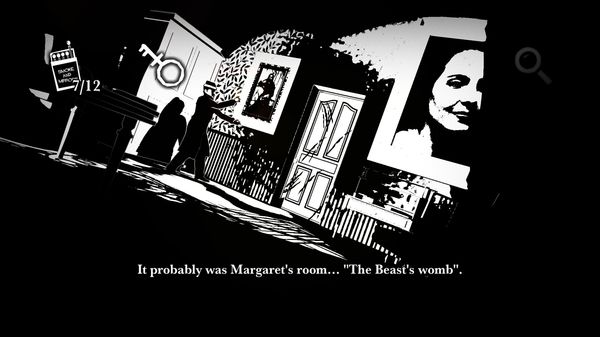White Night: Black Hat

Film noir, besides being about hard-boiled detectives and seductive, less than scrupulous women, is a genre about contrasts. It’s about duality, secrets, tension, suspense, shadows, the inherent darkness in humanity. Granted, it’s kind of a tired subject in the new millennium, an old genre that has been thoroughly revived and explored of late, but it’s what we’re left with in White Night, a game that takes motifs surrounding black and white to the extremes. And we kind of have to deal with it.
Osome Studios’ new survival horror point-and-click adventure White Night takes a lot of notes from film noir, creating an environment that’s recognizable from the start. You get the typical baritone voice over, spaced out over shadowy images and Dutch angles, the kind of camera work featured prominently in classics such as The Third Man or Touch of Evil. It’s a mystery, taking a cue from the later works of Alfred Hitchcock by delving into the supernatural in ways that the gritty, realistic films of the 1930s almost never bothered to. There’s an undercurrent of angst stemming from the Great Depression, with commentary on greed. You have the hard-boiled, middle-aged man, confused and masculine, draped in a long trench coat and wearing a fedora like it hasn’t gone out of style yet. You have a beautiful, seductive woman that (literally) glows as the protagonist glances at her for the first time. But she has a secret past—possibly a jealous ex-lover? Oh, and that lover is most likely a serial killer, so there’s a mystery that you also have to solve. And let’s not forget about that smooth, soulful jazz.
There’s a lot of tropes here to get through. White Night is a love letter to the 1930s and ‘40s, but it tends to become overwhelming. Granted, as previously mentioned, film noir is about duality and extremes, but the game tends to exaggerate them. The color palette is black and white with no grays or in-betweens. Skin is blank, sometimes blending in with eyes, clothing and backgrounds. Shadows are especially dark, making it difficult to find certain crucial objects unless you shine your light source just right. This, combined with fixed camera angles meant to evoke the cinematic, sometimes makes it impossible to move forward without first running around in circles or missing hallways. This becomes even more complicated when you have to flee from the spirits that plague the corners of the darkened manor and keep inadvertently running into them. If you aren’t near a save point (represented here with soft chairs that are illuminated permanently with light) you’ll have to redo large portions of the level.
The trouble with White Night then seems to be that it has a lot of ideas, which isn’t inherently a bad thing. The game is filled with enthusiasm, able to successfully transport the player directly into the landscape, and there’s very little confusion about what you’re getting into, especially when it comes to the atmosphere. You expect a lot of the typical film noir tropes because the piece is just completely immersed in the stuff. This lends well to an unsettling horror experience suffused with shadows, ambient sound and despair. You’re unsure about where the scares are going to come from, but you are made uncomfortable from the start. The Vesper manor, where you crash your car, has a small cemetery in its front yard. In the foyer, there are muddy footprints coupled with a shovel. As the lights flicker throughout each room and the music swells and your heart beats in your ears and you start to see your supply of matches—your only constant light source—dwindle, you begin to get anxious. That’s before the ghosts appear and the secret rooms emerge and you start to wonder what you’re even doing there.
The love the developers have for the genre and their project is evident in each scene. You find letters and journals scattered around the manor that provide more detail into the Vesper family, the ghost Selena that wanders the halls in a suicidal daze, and the Great Depression. There’s a full family curse that almost perfectly blends elements of the paranormal with fears surrounding disease, technology and greed. The game deals with mental illness in a way that is not exploitative, crafting a tragedy that puts the characters into situations that they don’t know how to handle, especially considering unknowns surrounding certain conditions in the early 20th century. It’s a surprisingly mature departure from the horror genre, which tends to convey mental illness as a plot device for more gore and scares, and it elevates White Night. The mainly jazz soundtrack blends old school instruments with more modern touches, a nice mix of the film noir style the developers were going for with a sense that they are pulling from more contemporary influences. Not only does this all show that the creators have a respect for the genres they are playing with, but also that they wanted to put as much detail in as possible, even if a lot of the elements are hard to find or fade into the background.
